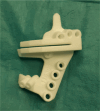3D-printed patient-specific instrumentation and the freehand technique in high-tibial osteotomy: A prospective cohort-comparative study in an outpatient setting
- PMID: 39839856
- PMCID: PMC11747140
- DOI: 10.1002/jeo2.70088
3D-printed patient-specific instrumentation and the freehand technique in high-tibial osteotomy: A prospective cohort-comparative study in an outpatient setting
Abstract
Purpose: Tibial valgus osteotomy has shown to be a successful and cost-effective procedure. The advent of image processing and three-dimensional (3D) printing is an interesting tool for achieving more accurate and reproducible results. The aim of our study was to compare the accuracy of the conventional technique and the use of customized guides in the correction of tibial deformities in tibial varus patients, the surgical and clinical benefits, and the impact of treatment in the outpatient setting.
Methods: A prospective cohort of 30 patients who underwent tibial valgus osteotomy were selected and randomized into two groups (3D-printed guidewires and conventional techniques). All patients underwent a complete radiological study to plan the surgical procedure. During the surgical procedure, the surgical time and X-ray exposure were analysed. The following results were evaluated: surgical time and X-ray exposure, the correlation between the planned correction and the correction obtained at 3 post-operative months, pre- and post-operative knee injury and osteoarthritis outcome score (KOOS) value at 3 and 12 months, and differences between the two groups in terms of the correction obtained.
Results: Radiation exposure in the '3D-guide' group was significantly different (8 [±4.51], p < 0.05), whereas surgical time was not significantly different between the control and guide 3D groups (60.69 [±8.89] and 53.43 [±11.69], respectively). At the 3-month follow-up, the post-operative hip-knee-ankle and post-operative mechanical-proximal-tibial angle were not significantly different (p > 0.05). At 3- and 12-month post-surgery, the Knee Injury and Osteoarthritis Outcome Score (KOOS) did not significantly differ between the conventional technique and the 3D-guide technique (p > 0.05). The KOOS at 3 months were 87.86 (±5.64) for the control group and 88.46 (±3.53) for the 3D-guide group, while at 12 months they were 91.5 (±5.72) for the control group and 88.57 (±8.81) for the 3D-guide group.
Conclusion: Customized 3D-printed guides do not permit better correction or functional results than the conventional technique; rather, they reduce surgical time and intraoperative radiation exposure.
Level of evidence: II.
Keywords: 3D printing; knee; open wedge knee osteotomy; patient‐specific instrumentation; tunnels.
© 2025 The Author(s). Journal of Experimental Orthopaedics published by John Wiley & Sons Ltd on behalf of European Society of Sports Traumatology, Knee Surgery and Arthroscopy.
Conflict of interest statement
The authors declare no conflicts of interest.
Figures
References
-
- Ahlbäck, S. & Rydberg, J. (1980) [X‐ray classification and examination technics in gonarthrosis]. Lakartidningen, 77, 2091–2093, 2096. - PubMed
-
- Aman, Z.S. , DePhillipo, N.N. , Peebles, L.A. , Familiari, F. , LaPrade, R.F. & Dekker, T.J. (2022) Improved accuracy of coronal alignment can be attained using 3D‐printed patient‐specific instrumentation for knee osteotomies: a systematic review of level III and IV studies. Arthroscopy: The Journal of Arthroscopic & Related Surgery, 38, 2741–2758. Available from: 10.1016/j.arthro.2022.02.023 - DOI - PubMed
LinkOut - more resources
Full Text Sources
Research Materials



